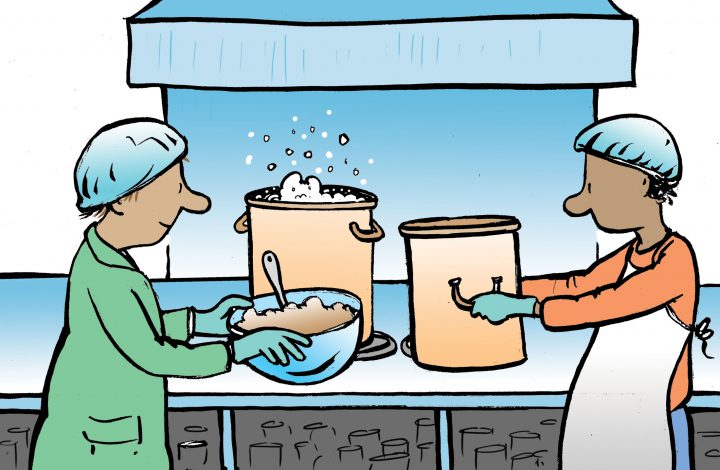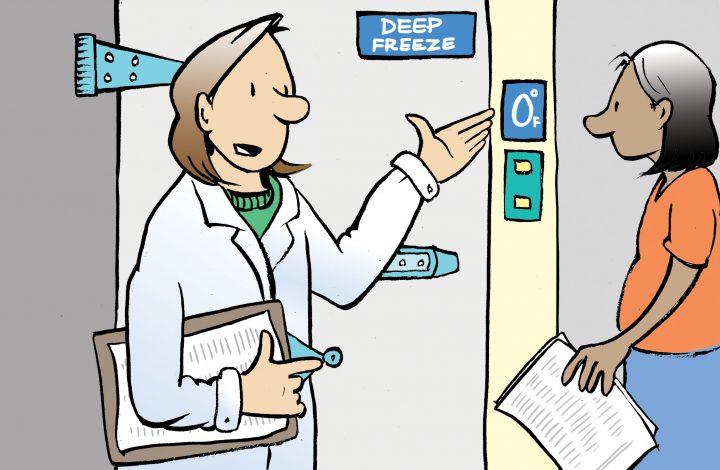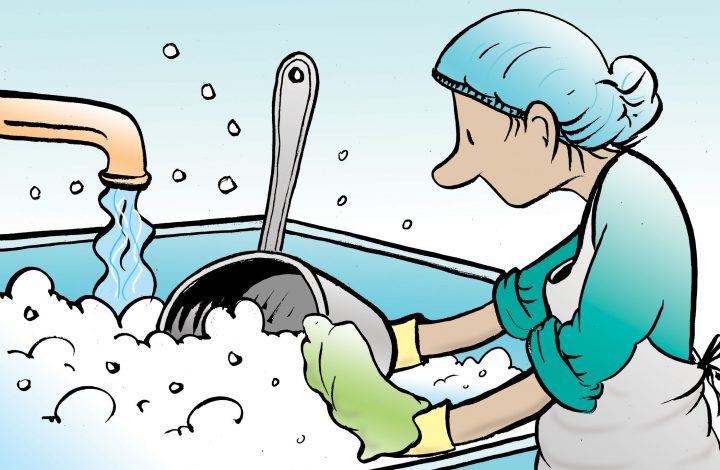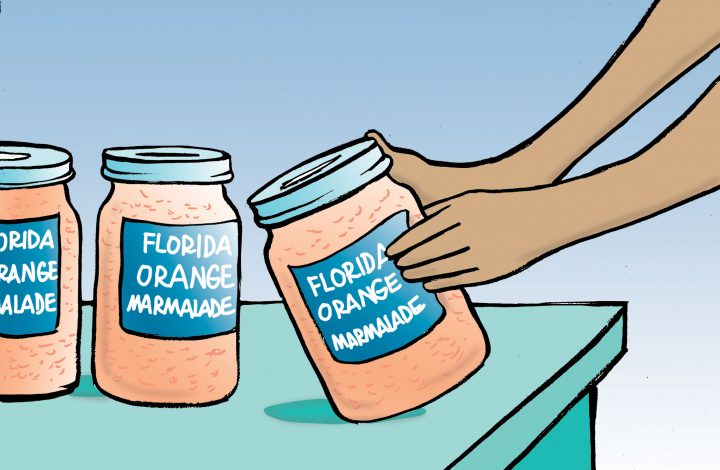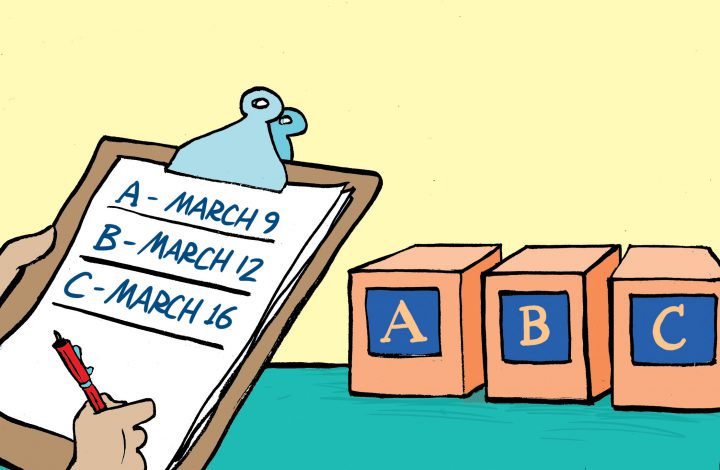The lot code allows for tracking from the consumer back to the original producer or manufacturer. Even under the best circumstances, unintentional hazards can enter the food production system.
A robust inventory control system enables a food manager to identify potentially contaminated products and prevent the sale and distribution of food that may be harmful to human health. For consumer protection, food safety regulatory agencies require food retailers and wholesalers to have a system in place that will allow health regulators to trace the pathway of a product from the producer to the consumer or from the consumer back to the producer. This guide will cover simple and easy steps to create a basic lot-coding system, steps to develop an inventory tracking system, and address recall procedures in the event of a potential contamination
Lot-coding
The lot code is a unique code assigned to each batch, or lot, of products that allows the food manager of a business to trace each product from the the manufacturing/production system to the consumer. If there is a health issue with the food product and a recall is issued, the lot code also allows for tracking from the consumer back to the original producer or manufacturer. A lot number is usually a sequential number assigned to a specific lot produced on a specific day and time, and this helps to distinguish products that were created in different batches. Lot numbers are never reused, because the number is a unique identifier for a specific batch.
A lot number can be as simple as the date the batch was produced if it was the only batch produced on that day. Food producers may opt to use combination codes that that include a product code (a unique number and/or letter assigned to each type of product), a facility code (a unique number and/or letter assigned to each facility used to produce the batch), and possibly an employee code (a unique number and/or letter assigned to the employee who produced the product).
Some examples of combination lot codes:
-
-
- AS-AUG152017 with ‘AS’ as the product code assigned to the type of product such as ‘canned beans’ and ‘AUG152017’ refers to the date the beans were canned
- AS-X-Aug152017 with ‘X’ as a location code assigned to a specific farm where the beans were sourced
- AS-X1-August152017 with ‘1’ as a facility code assigned to a specific kitchen where the beans were canned
- AS -X1-d-August152017 with ‘d’ as the employee code assigned to the person who canned the beans
The consumer does not need to understand the lot coding system because the lot codes are used by food producers and regulatory officials to trace a specific product back to its origin or to track down and reclaim products that are suspected to be hazardous. If a food product is found to be contaminated, the food business and food safety inspectors can use the lot code to identify, isolate and stop the sale and distribution of potentially contaminated products with that same lot code.
Without a lot code and inventory tracking system, the food business will be forced to recall ALL products when there is a potential for contamination. Therefore, a simple lot coding and tracking system can save a lot of money and time.
Recall is not only an ethical obligation to public health, but it also protects the liability, brand and reputation of a farmer’s market business.
Inventory Tracking Systems
An inventory tracking system is a way to keep records of information for each batch of products such as when the batch was produced, who produced the batch, where the ingredients were sourced, and where the products from the batch were sold. The tracking system should include a record of the meaning of each symbol in the lot code so that anyone using the tracking system can easily interpret the codes.
Tracking inventory can be as simple as maintaining a book of invoices that includes the lot codes, customer names and addresses, and the date of each sale on each invoice. Some small food producers use blank ledgers or adapt stock ledgers sold inexpensively at most office supply stores. There are a wide variety of printable templates or computer record-keeping templates available for free online, and several low-cost online accounting programs integrate inventory management with invoicing and lot coding for quick and easy inventory tracking.
Recall: When Something Goes Wrong
If there is reason to believe that a food product is potentially hazardous, a food business or food safety regulator will initiate a recall to stop the sale of the affected foods. When the circumstances require a recall, the food business operator must inform the regulatory agency of the actions taken and follow the instructions and guidelines relating to official food recall procedures. A few reasons to recall a food product include but are not limited to:
- Discovering biological hazards, such as pathogens, in a product which may make customers sick
- Discovering physical hazards, such as metal shavings or bone shards, in a product that can harm customers
- Discovering chemical hazards, such as cleaners or lubricant, that was used during production.
- Mislabeling of ingredients, such as nut allergens, that were not included on the label
- A consumer-driven complaint alerts the business or food safety regulators of a health hazard in a product
After a recall is initiated, the food business should work with state food safety regulators through three steps:
| Step One: Investigate |
Identify the lot code and refer to the inventory tracking system to determine any affected products and source(s) of contamination. Identifying the lot code will reduce the number of products affected by the recall. Provide federal and state inspectors an up-to-date inventory of the product, ingredients used in the product, a list of customers who received the product, and assistance with interpreting the meaning of product or lot codes used in the tracking system. |
| Step Two: Notify Consumers |
Conduct outreach and communicate with all customers with information about the recall if the affected products have been released for sale. Communication should include; product name, lot code on label, package description and size, photo of product, reason for the recall, recall instructions, and contact information. Provide press releases, letters and other documentation to demonstrate public notification if affected products have already been released to the consumer |
| Step Three: Restore & Recover |
Verify that all products from the affected batch have ceased distribution and been recovered. Compare the amount of products sold to the number of products reclaimed or confirmed destroyed. Assist regulators with an ‘effectiveness check’ to ensure all potentially hazardous products have been recovered |
Proper packaging protects the product and labeling provides important information for the consumer as well as the business
Inventory, Lot-coding, and Recall Procedures for your Farmers’ Market Business
Managing inventory, implementing a lot-coding system, and developing recall procedures demonstrates to the consumer that a farmers’ market food business accepts the legal responsibility to ensure that products are safe, sanitary, and accurately labeled. Recall is not only an ethical obligation to public health, but it also protects the liability, brand, and reputation of a farmers’ market business.
The impact of a recall on a food business can be minimized with an efficient and organized lot coding and tracking system as well as a quick response when a potential problem occurs. For more information related to inventory, lot-coding, and recall procedures, visit the Point of Sale, Business Plan, Financial Plan, and Package & Labeling guides on this website.

